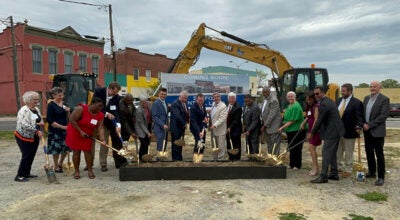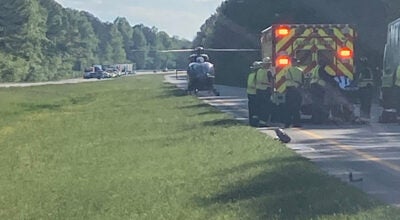Planning Commission backs CIP
Published 2:40 pm Thursday, January 27, 2022
|
Getting your Trinity Audio player ready...
|
The Planning Commission unanimously gave its backing to the city’s 10-year Capital Improvement Program and Plan.
The plan, which goes from fiscal year 2023 to 2032, now goes to City Council, which will get its first official look at it during its Feb. 5 meeting. It has a five-year total of more than $371.4 million in projects, though only the first-year allocations in the plan move forward to the city’s budgeting process.
The first year of the plan calls for more than $59.3 million in spending — $44 million of that coming from the general government fund, nearly $9.3 million from the public utilities fund, nearly $5.5 million from the stormwater fund and $500,000 from the information technology fund. The city proposes issuing $29.9 million in general obligation bonds in the first year, and is expected to issue at least $29.5 million in bonds over the next four years after that as the city looks to preserve its AAA bond rating.
City Finance Director Tealen Hansen, who presented the plan to the commission last month, briefed members on it again before they voted to recommend it at their Jan. 17 meeting. Hansen will present the plan to council at its Feb. 2 meeting, with a public hearing scheduled for Feb. 16, the first opportunity it will have to adopt the plan.
Commissioner Mills Staylor asked about the $30 million limit the city has set its general obligation bond debt capacity to and why it hasn’t been adjusted. Hansen said one of the reasons to keep that level is because the city wants to keep the high payout ratio in relation to its debts, “so that we’re not getting in over our heads.”
Staylor also said that with a lot of capital investment in the Holland Road corridor, a new fire station for that area should be a higher priority in the CIP.
The first year of the fund calls for about $4.1 million for the new College Drive fire station, around $2.3 million for new and replacement fire apparatus, just over $400,000 for ambulances and $100,000 for a breathing air system. No CIP money for a new Holland Road fire station near the Port Logistics Park shows up until fiscal years 2028 to 2032.
Public schools would receive $73.7 million in the first five years of the CIP, and just over $11 million in the first year — $7.5 million to begin replacing John F. Kennedy Middle School and more than $3.5 million for schools major repairs/systems replacement. The JFKMS replacement is slated to receive another $22 million in the second year and $20.5 million in the third year. An addition to Northern Shores Elementary would receive $1.2 million in the second year, and a combined $14 million in years three through five.
In the initial draft CIP City Manager Al Moor unveiled during a joint meeting of council and the School Board, money for a new middle school for John F. Kennedy was there, but it did not have Northern Shores Elementary receiving any CIP money until fiscal 2026.
More than 40 transportation projects would receive $110 million in the first five years, including about $9.8 million in year one for projects such as the traffic operations center ($2 million), citywide signal timing ($586,681) and the Freeman Mill bridge over the Spivey Swamp ($484,000).
The largest part of the transportation CIP over the next five years will go toward the Diverging Diamond Interchange at Godwin Boulevard at the U.S. Route 58 Bypass ($16.4 million combined in fiscal 2025 and 2026). The Virginia Department of Transportation has done some preliminary reviews of the concept and supports it, according to city spokesman Tim Kelley (More info on the type of proposed interchange: https://www.virginiadot.org/info/innovative_intersections_and_interchanges/ddi.asp). It is being funded through VDOT’s Smart Scale program. Additional improvements to Godwin Boulevard ($11.1 million in fiscal 2026) and U.S. Route 17 road widening ($12.8 million combined in fiscal 2025 and 2026) also make up significant parts of transportation projects in the CIP in future years.
There are about $17.7 million in Parks and Recreation projects in the CIP over the five years, but just $710,000 in the first year. The Driver Complex is slated to get $6.2 million over five years, with the first bit, about $1.7 million, that would come in fiscal 2024.
Nearly $16.6 million — and around $26.2 million over five years — would go toward public buildings and facilities, including $6.5 million in the first year toward renovation of the Human Resources building, while $2 million would go to village and neighborhood initiatives.
Among the five-year general government CIP expenses, 42% would be spent on transportation, 28% on schools, 10% on public buildings and facilities, 8% on public safety, 7% on Parks and Recreation, and 5% on village and neighborhoods.
The largest amount of local money over the first five years of the CIP would go to schools (41%) and transportation (20%). The majority of the revenues for the first five years of the CIP would come from bonds (55%), followed by state, federal and other money (31%) and the city’s general fund (14%).
More information
See the CIP Subcommittee recommended Capital Improvements Program and Plan for fiscal years 2023 through 2032: https://www.suffolkva.us/DocumentCenter/View/6328/FY-23-32-CIP-Subcommittee-Recommended-Capital-Improvements-Program-and-Plan






